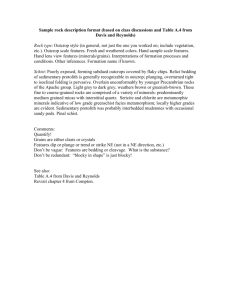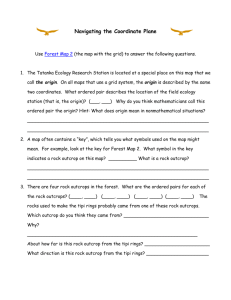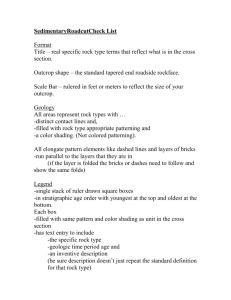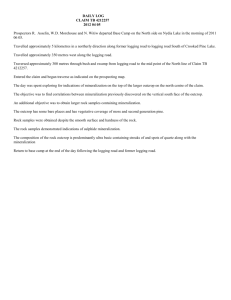diss_abs_intro
advertisement
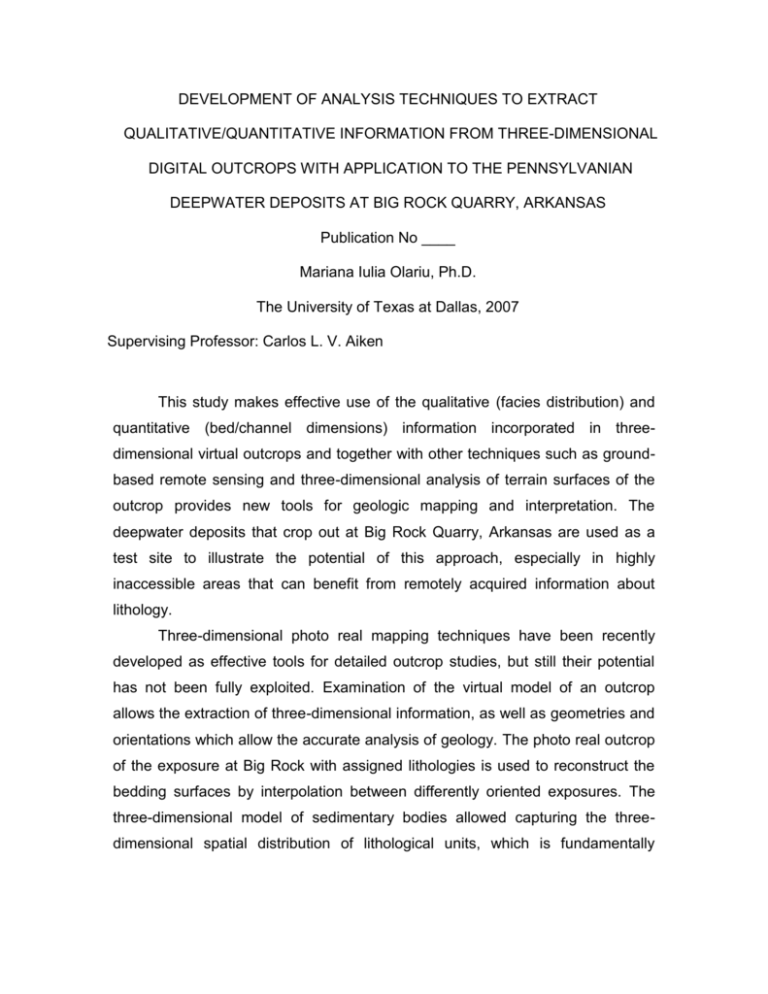
DEVELOPMENT OF ANALYSIS TECHNIQUES TO EXTRACT QUALITATIVE/QUANTITATIVE INFORMATION FROM THREE-DIMENSIONAL DIGITAL OUTCROPS WITH APPLICATION TO THE PENNSYLVANIAN DEEPWATER DEPOSITS AT BIG ROCK QUARRY, ARKANSAS Publication No ____ Mariana Iulia Olariu, Ph.D. The University of Texas at Dallas, 2007 Supervising Professor: Carlos L. V. Aiken This study makes effective use of the qualitative (facies distribution) and quantitative (bed/channel dimensions) information incorporated in threedimensional virtual outcrops and together with other techniques such as groundbased remote sensing and three-dimensional analysis of terrain surfaces of the outcrop provides new tools for geologic mapping and interpretation. The deepwater deposits that crop out at Big Rock Quarry, Arkansas are used as a test site to illustrate the potential of this approach, especially in highly inaccessible areas that can benefit from remotely acquired information about lithology. Three-dimensional photo real mapping techniques have been recently developed as effective tools for detailed outcrop studies, but still their potential has not been fully exploited. Examination of the virtual model of an outcrop allows the extraction of three-dimensional information, as well as geometries and orientations which allow the accurate analysis of geology. The photo real outcrop of the exposure at Big Rock with assigned lithologies is used to reconstruct the bedding surfaces by interpolation between differently oriented exposures. The three-dimensional model of sedimentary bodies allowed capturing the threedimensional spatial distribution of lithological units, which is fundamentally important for understanding the internal architecture of erosional and depositional features, in this case channelized features. Multi-spectral analysis has been successfully used from space and airborne platforms, but in this study it is used to remotely sense lithology at outcrop scale, obliquely at close range with an increased spatial and spectral resolution. Local outcrop level geology until recently has remained basically nondigital. The methods that have been developed define geometries, but what is lacking is lithology. This multispectral approach provides this important aspect of digital geologic mapping beyond the visible range. Analyses of the spectral characteristics of sandstone and shale samples from the outcrop at Big Rock within the visible and infrared portion of the electromagnetic spectrum has identified spectral responses of these sedimentary rocks. Multi-spectral images have been acquired using a thermal camera for the infrared part of the spectrum and a conventional digital camera for the visible range. Spectral images obtained from the outcrop are co-registered and displayed in Red-Green-Blue color space to create false color images that are useful for highlighting lithologic variation. By developing a surface classification algorithm for fracture identification and orientation it was possible to evaluate the fracture geometry, which is helpful in interpretation of reservoir quality. High-density, high-accuracy terrestrial laser scanners have been use to capture the surface morphology of the outcrop at Big Rock. Visualization and analysis of the centimeter-resolution terrain data provided a characterization of this fracture system. Conventional outcrop information combined with new techniques such as three-dimensional detailed geologic mapping, ground-based multispectral imaging and 3-D analysis of terrain surfaces of the outcrop can add valuable information for a better description and interpretation of deepwater sedimentary successions in particular, but geology in general. CHAPTER 1 INTRODUCTION 1.1 Overview This dissertation comprises three papers (Chapters 2, 3, and 4) which highlight the usefulness of integrating different techniques for a more comprehensive understanding of the outcrop geology. Deep-sea sediments have received considerable interest both for research purposes and economic reasons due to large hydrocarbon accumulations associated with turbidite deposits (Bouma et al., 2000). Ideally, characterization of hydrocarbon reservoirs requires information about heterogeneity at a submeter scale in three dimensions. Typically surface (wells and wire logs) data provide very detailed, but much localized geologic information while subsurface (2-D and 3-D seismic) data have limited vertical resolution. One solution is to characterize shale-sandstone distribution using data from outcrops (Coleman et al., 2000) since large, continuous 3-D exposures provide quantitative lateral and vertical attributes of strata and their bounding surfaces (Slatt, 2000). However, most of the time geologic interpretation is made on 2-D photo panels of outcrops which are affected by distortions and parallax effects. Interpreted measurements may also be influenced by the shape and orientation of the exposure (Pringle et al., 2001). Recently developed threedimensional photo real mapping techniques (Xu et al., 1999; Thurmond et al., 2000; Xu, 2000) are effective tools for detailed and accurate quantitative outcrop studies. This project proposes to study the 3-D geometry of the sedimentary bodies and facies distribution, as well as channel morphology of the turbidite deposits that crop out at Big Rock Quarry, Arkansas. Outcrop sedimentological information combined with new techniques such as mapping geology in threedimensions on the virtual outcrop, facies discrimination based on ground-based, close range, oblique infrared photography and three-dimensional analysis of terrain surfaces of the outcrop provided new tools for quantitative mapping of sedimentary facies and interpretation. Making effective use of the 3-D methods developed in this study we were able to evaluate the potential improvement over classical 2-D methods that have been used to build reservoir analog data bases. Big Rock outcrop belt exposes a three-dimensional view of the lower part of the upper Jackfork Group (Jordan et al., 1993) along the north bank of the Arkansas River in North Little Rock, Arkansas. In the study area Jackfork Group is divided in lower Jackfork (Irons Fork Mountain Fm.) and upper Jackfork (Brushy Knob Fm.). The Jackfork Group was dated on the base of correlative units on the shelf and it is Pennsylvanian (Morrowan) in age. The horse-shoe shape of the quarry provides an oblique strike view toward southeast and an oblique dip view toward northwest. The quarry walls are up to 60 m high and about 1200 m long. Excellent cliff faces exposed at Big Rock were interpreted as proximal deep-water fans within slope channels canyons (Jordan et al., 1993), but the geometry of these deposits was difficult to be interpreted due to highly variability of bed thickness and lateral discontinuities in three dimensions. The first manuscript effectively uses 3-D qualitative (lithology, lateral continuity of sedimentary bodies, channel morphology) and quantitative (bed and channel dimensions) information contained in the virtual outcrop at Big Rock to reconstruct the submarine channel complex architecture. Oblique close-in photography acquired with a digital camera is integrated with terrain data and converted into a 3-D digital photo real model of the outcrop. Digital mapping or photo real mapping techniques were developed at UT at Dallas for outcrop studies (Xu et al., 1999; Xu, 2000; Xu et al., 2000). A real time kinematic (RTK) – global positioning system (GPS) combined with a robotic reflectorless laser rangefinder captured 3-D terrain data of the outcrop in global coordinates within centimeter accuracy. Digital photography was taken at the same time for a 3-D photo real model. Examination of the digital model of the outcrop with assigned lithologies allows for extraction of 3-D accurate geometric information and geologic interpretation. Key stratigraphic features such as bed/channel boundaries are highlighted on the 3-D photo real model making possible correlation of strata/channels exposed on the two distinct sides of the quarry. Reconstruction of body geometry was accurate in areas where lithologies were highly distinct and where surfaces/bodies can be correlated on the two walls of the quarry. The second manuscript uses multispectral imaging to assess how well sandstone may be detected versus shale in a deep-water sedimentary succession. Remote sensing analysis for lithologic mapping is common, but here it is applied to digital acquisition from the ground at close range, obliquely to demonstrate its use in detailed outcrop mapping. Using a combination of visible spectrum (red, green, and blue bands) and a wide thermal infrared band (2-14 μm) false color images are created that are useful for highlighting lithological units on outcrop. The thermal channel has been used because surface temperature distribution may contain relevant information about rock distribution in the scene and also because the three visible bands are highly correlated to each other. Discrimination of different lithologies based on the spectral characteristics has been made using image processing techniques, such as principal component analysis. The third manuscript develops an automated and objective method for fracture identification with applicability especially in inaccessible outcrops. Determination of fracture orientation and density can be an important aspect of structural analysis and reservoir characterization. Typically a detailed survey of fractures in outcrop is done by visual observation. This technique, although precise, is labor and time intensive and hampered by the limited amount of data obtained especially from large exposures to be used for statistical analysis. Our surface classification algorithm provides an easy and automated way to quantify fracture information at outcrop scale. The exposure at Big Rock has a blocky aspect due to preferential weathering on the fracture planes. Orientation of fractures in outcrop is determined based on their geometry. High-density terrestrial laser scanners proved very useful to capture the 3-D surface morphology of the outcrop and the exposed fracture surfaces. These automatic, fast, high-accuracy laser scanner systems produced enormous volumes of point cloud data at centimeter resolution. An unsupervised pattern classification technique was developed that can extract surface orientation information directly from the point cloud. Analysis of the high quality, high resolution three-dimensional terrain data indicated how fractures are distributed in the rock volume. Combining 3-D digital lithologic mapping with multispectral mapping and three-dimensional analysis of terrain surfaces of the outcrop at centimeter detail the amount of information is increased tremendously and the exposed variation in sand and shale can be considered in modeling the flow.
